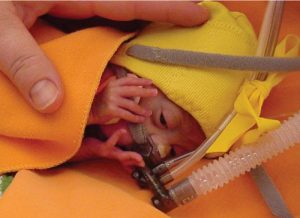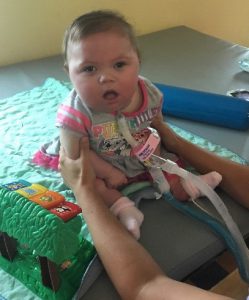 By: Jacqueline Grimenstein, PT, C/NDT, CKTP
By: Jacqueline Grimenstein, PT, C/NDT, CKTP
Physical, Occupational and Speech therapists play a critical role in the treatment of children with chronic airway diseases. Bronchopulmonary Dysplasia or BPD is a chronic lung disease primarily found in infants born prematurely resulting in respiratory distress syndrome (RDS) and require oxygen from birth. This oxygen is delivered by nasal prongs (cannula), a mask, or breathing tube. Most infants who develop BPD are born more than 10 weeks early, weigh less than 2 pounds, and have breathing problems. Infections before or shortly after birth can contribute to BPD. If a premature infant continues to require oxygen by the time they reach 36 weeks gestation, they are diagnosed with BPD (www.nhlbi.nih.gov).
Some of these infants will continue to require the use of oxygen for breathing support using Nasal Continuous Positive Airway Pressure (NCPAP) BiPAP or mechanical ventilation, and medications like bronchodilators. Breathing issues may persist throughout childhood and even into adulthood (www.nhlbi.nih.gov).


Most breathing issues in children can be managed at home. If the child requires long term use of mechanical ventilation, the family will receive training by respiratory therapists to focus on signs and symptoms of medical issues, the set-up, settings, and care of the ventilator and accessories, and how to respond to alarms and emergencies. For a child to be at home on mechanical ventilation, more than one family member or another readily available person is trained to assist if the primary care giver is not available. This training is necessary because many families receive additional home nursing care, but typically less than 24 hours a day.
As therapists, we provide services for children with BPD. As with most preemies, physical, gross, and fine motor development are also concerns. Being attached to mechanical ventilation has its physical limitations with the length of the tubing and wires from the pulse oximeter. This can be intimidating to families and therapists when the child becomes active, but should not hinder activities. It is important for therapists to facilitate muscles and patterns to improve respiration and mobility with an emphasis on developing rib cage mobility and multiple planes of movement. Children with BPD tend to primarily use sagittal plane movement because of the mobility limitations and significant amount of time spent in supine during early weeks of life. Development of multiple planes of movement help activate the oblique abdominals and improve depth of respiration. Therapists and families are often concerned about putting the child in prone, but this position is advantageous to developing movement and improving respiration. Prone positioning improves extensors muscles to allow for more upright sitting, lung expansion and support of the diaphragm.
Sensory impairments can also be a concern due to lack of experience in exploring the child’s environment. Therapists and families should incorporate use of multiple textures and vestibular activities into the child’s daily routine. This will help to build their tolerance and acceptance of a wider variety of clothing, textures, and sounds. Limited movement patterns can affect the ability to use vision in multiple planes for the child to explore their environment.
Children with BPD depend on their families and therapist for their success in development. Therapists are instrumental in helping family members develop confidence in encouraging the child to move and develop motor milestones across all domains.
If treating children or adults with significant impairments is an interest, please check out my live or online course, “Treatment of the Child with Severe Impairments,” here!
For more information:
Continuous Positive Airway Pressure; Morgan Stanley Children’s Hospital, May 12 ,2007 https://www.youtube.com/watch?v=PM4Dm3bFZg0
Non-Invasive Ventilation in Pediatric Medicine, Jenner Lakusta, Dr. Jonathan Duff and Dr. Chris Novak, May 2018. www.pedcases.com/podcasts.
CPAP vs BiPAP: Non-Invasive Ventilation Explained, ICU Advantage. Jan 2020, https://www.youtube.com/watch?v=Te0WLR71HwA
What is Mechanical Ventilation: Ventilators Explained, ICU Advantage, Jan 2020. https://www.youtube.com/watch?v=E5uLM41URmE&t=18s
